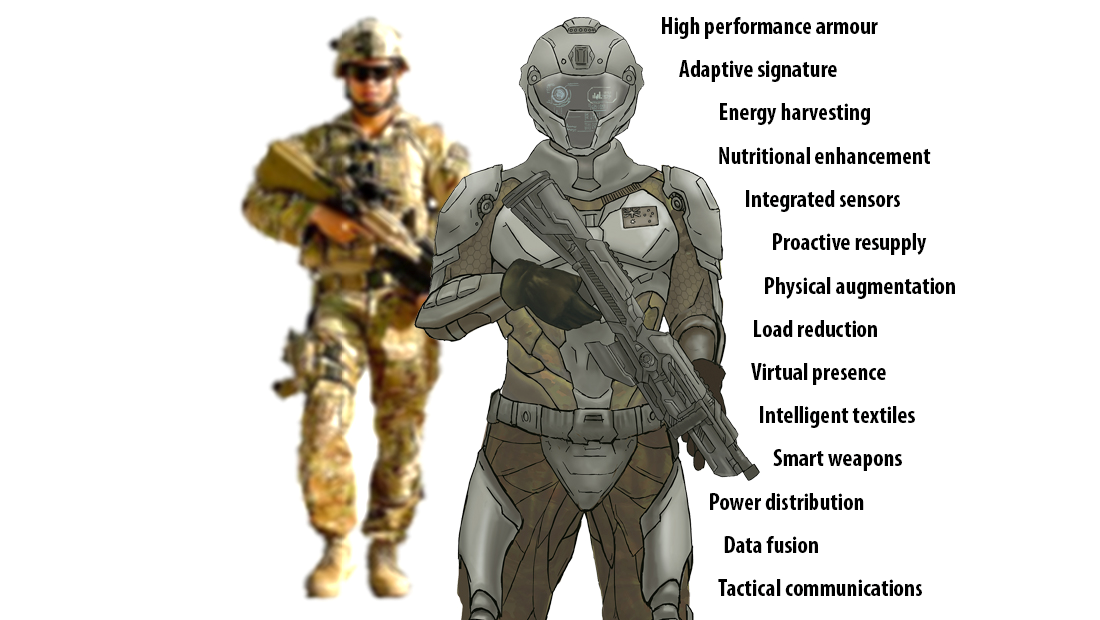A visit to Integrated Personnel Protection Group, DST
We see a lot of sketches, concepts and science-fiction about tomorrow’s soldier – but what about the materiel research and the proof of those concepts? Recently, I had the privilege to visit Defence Science and Technology (DST) Group’s campus at Fishermen’s Bend, Melbourne, to see our scientists developing the cutting edge technology for a future soldier concept, nicknamed ‘Carl’. DST is where the theory turns into research, and solutions are provided for future trials and experimentation in land units – click here for more on their structure, or here for their locations.

Under Dr Peter Shoubridge, Head of Land Systems, numerous projects are underway at DST Fishermen’s Bend – only one of DST’s many sites in Australia. Although other capabilities are tested in these various campuses, Melbourne is home to Tim Bussell’s Integrated Personnel Protection (IPP) group. IPP forecasts, designs and evaluates concepts for the soldier of the future – as in, the kind of future when our kids will be able to join the Army: beyond the year 2035.
Check out the DST video on this concept first where you’ll see Carl resembles Master Chief from Halo. There’s a place for science-fiction in Defence conversation—other articles (such as BRIG Mick Ryan’s post about why reading science fiction is good for military officers; and Tom Bittner’s advocacy for science fiction TV shows) have noted its importance in driving our discussion for tomorrow’s battlespace. ‘Carl’, however, is not science fiction; Carl is the real-life work in progress at IPP Group, using technologies available today or forecasted as requirements for the future.

Mark Ryan, one of the scientists tasked with making “Carl” come to life, highlighted some of the areas that are theoretically feasible, such as metabolic cooling or data fusion. Metabolic cooling would prolong soldiers’ working time in armour or CBRNE suits by using their body heat to power a cooling system, whilst being lightweight and flexible. Exoskeletons are not new but being perfected for a range of soldier support tasks in line with the Robotics and Autonomous Systems Strategy (RAS Strategy) that was signed off by our Chief of Army last year. Similar to concepts seen in the United States’ Future Warrior Program or Russia’s ‘Ratnik’ Soldier Program, the IPP Future Soldier is an evolving concept offering significantly greater protection and capability to Australia’s future (2040s) soldiers.
Future soldiers should expect intelligent textiles to draw moisture away from their body whilst being rainproof – removing the requirement for a future wet weather jacket or pants. If you’ve read The Next 100 Years by the founder of StratFor, George Friedman, you’ll know where the future force is heading with mech-infantry bringing more endurance and lethality to the battlespace – a concept also echoed in LTCOL Rowland’s writing on future warfare here.

Geoff White’s team is working on the mesh networks, low-cost ground vehicles, and integration with advanced software algorithms that will be central to tomorrow’s soldiers and support vehicles. The key, he says, is to look past the platform and focus on the software that will be reconfigurable and shareable to future platforms which will be more suited to the future battlespace conditions. Everything on the network is the extension of a computer, and the future soldier will also be an extension of this network, down to the command gloves that will enable the natural ‘gesture control’ of supporting vehicles.
The future firefight is projected to be in an urban battlespace. Robots will extend the weapon and sensor systems of each soldier, providing an enhanced 3-D view of buildings whilst freeing up radio communications from the traditional chatter of locating enemy positions. This data fusion is neatly presented in an augmented reality, via ballistic glasses – another technology that also isn’t new but still a long way from being properly integrated into the soldier’s suit for tomorrow’s battle.
You might be thinking now that this “Carl”-suit is going to suck up a lot of battery power or require constant recharging. Luckily, the energy-harvesting boots are being designed to convert kinetic energy into electrical energy for the soldier-user. The future suit will be flame retardant (fireproof), and able to withstand harsh weather conditions. Ultimately, the multi-functional armour will not only have a multi-hit capability, but also introduce smart camouflage that is adaptive to the surrounding environment’s brightness, colour and shades.
Though the nature of war may not change, the team at IPP will ensure the men and women of tomorrow’s Army will be at a significant advantage from their enemies, and able to integrate with allied capabilities as well.
Jacob Choi visited Land Systems Division, DST, as the winner of the 2018 DEF Entrepreneurs Forum for his pitch on Swarmed Autonomous Resupply Concepts, which can be found at this link. Readers with an interest or background in Defence Science and Technology can find Army’s Liaison Officer at Fishermen’s Bend, MAJ Bart Kaymakci at bart.kaymakci@dst.defence.gov.au

